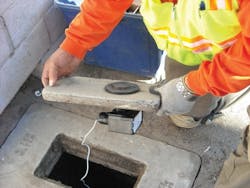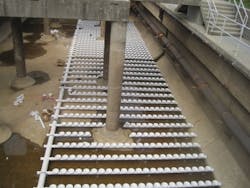Asset Management Helps Drive Organizational Change
Corpus Christi is one of the largest cities on the Texas Gulf Coast. The city manages six wastewater treatment plants, two reservoirs, approximately 1,250 miles of wastewater gravity mains, 1,500 miles of water distribution mains, and a water treatment plant with a 170 mgd capacity. The system is responsible for providing safe, clean water to the city’s population of more than 280,000 while simultaneously keeping operating costs low.
In 2000 Corpus Christi faced the threat of utility privatization. Many assumed the private sector could do a better job than the city. Ultimately, the City Council directed the City Manager to take necessary actions to make the utilities more competitive after narrowly voting not to pass the motion to initiate the privatization process. City staff reviewed its management of water, wastewater, utility and storm water services and realized the need to improve management systems and implement improvements city wide.
“Competition from the private sector in 2000 was a wakeup call for the city,” said Gustavo Gonzalez, Water Director for the City of Corpus Christi. “It caused us to look critically at ourselves and seek ways to reengineer our organization. We realized in order to improve our water system we needed to reevaluate how we operate and find ways to simultaneously cut costs while adding value to our customers.”
Prior to this reassessment, each city department had its own process for handling incoming work requests and ongoing maintenance. There was no centralized location for customers to call or to issue work orders. With no computerized work and asset management system, city workers recorded customer calls on index cards and manually entered them into a departmental spreadsheet to record and track issues. This paper system left the staff with no accurate way to track how long it took to respond and fix problems and no way to view work history for each site, making it difficult to identify recurring problems or to analyze potential problems in the future.
Asset Management
After a system-wide assessment, the city of Corpus Christi decided to integrate software technology to better manage resources and improve maintenance procedures on mission-critical assets. The city chose to implement IBM Maximo Asset Management software as their enterprise work and asset management system (WAMS). Working with IBM, the city developed a system to effectively analyze data and provide intelligence and accountability into the way city services are managed.
“We viewed this as a management project rather than a technology project,” said Stephen Klepper, administrative superintendent of the City of Corpus Christi. “The idea was to implement new business practices city-wide not just to impose new technology over old practices.”
One critical organizational change was the development of the city-wide “One Call Center.” Citizen calls are now routed through a call center where service staff can record and track work orders and view work histories using the Maximo software. Through the call center the city is able to respond to customers more efficiently while simultaneously creating a digital, centralized database of real-time information. Working with IBM, Corpus Christi developed a system to analyze this data and use it to make better decisions in order to reduce costs and improve customer service.
The data collected by Maximo interfaces with the city’s geographic information system (GIS), giving the city a bird’s-eye view of its infrastructure and allowing staff to spatially analyze work requests. With this information, the call center manager is able to see all existing problems and determine scenarios such as the entire service area being affected or the existing location of assigned field workers in order to make management decisions.
Prior to Maximo and its interface with GIS, the city lacked the ability to spatially view where problems were occurring and where work was needed. Now the Water Department is able to better analyze the nature, causes and locations of any reported problems of water quality.
Staying Connected
In addition to the centralized database that gives field workers access to all of the same information, communication is being improved in other ways, such as how field workers are notified of problems. For instance, urgent requests for critical water work orders that can impact residents, such as pipe main breaks or water quality problems, are now received as e-mails on the smartphones of designated Water Department first responders. Field crews get real-time work order updates and directly update the work order status on their phones without having to go through a dispatcher. This increases the time crews can work in the field maintaining the city’s assets rather than in the office submitting paperwork.
Defining ‘Good’ Service
One key question that Corpus Christi aimed to address when it implemented the work and asset management system was how to define and measure good service levels. With its new system, the city established a framework to define, measure, and deliver good service, focusing on two distinct aspects of customer service: timely service and reliable service.
Using data from the WAMS, the city is able to track response times to citizen calls through the rate of work order status changes, and service reliability by tracking the number of reported back-up calls from specific locations. The city then uses that information to develop a systematic approach to help staff prioritize requests and deploy resources accordingly, based on urgency and service level requirements. For instance, if data shows that specific areas are experiencing sewer back-ups, the city prioritizes those areas.
Measuring Results
Corpus Christi’s water/wastewater department is now able to analyze projects, identify trends and proactively improve the reliability of water systems. For example, analysis of the city’s 3,843 water main breaks over a three year period revealed that smaller diameter mains comprised more than 15 percent of all breaks, allowing the city to formulate a replacement plan to reduce the amount of future system problems while improving service.
Through the call center system, staff identified that 33 percent of the wastewater department’s efforts were spent resolving back-up problems at just 1.4 percent of the customer sites. With this insight, the city was able to implement a repair strategy to resolve these ongoing issues, ultimately reducing costs.
Corpus Christi uses a program, the Balanced Score Card initiative, which is used to assess the city’s success. Maximo software provides the majority of the data for the public works and utility departments. The city measures city operations in four areas: customer service, financial management, process efficiency and sustainability. The initiative helps Corpus Christi see the entire picture of operations so management can evaluate the interrelationships of actions.
The city is continually working to put the right information in the hands of the right people to better manage utility operations.
“It is imperative for me to be aware of the status of mission-critical assets that could impair our ability to produce the water our customers expect,” Gonzalez said. “The objective of my Maximo ‘Morning Report’ is to continually provide us that information.”
The report is automatically e-mailed each morning and is based on real-time data. It identifies critical water plant assets currently down plus provides information on the current status of work orders associated with water main breaks or water quality problems.
Through Corpus Christi’s work with IBM the city has realized significant savings and increased service levels. However, Steve Klepper explained that the work doesn’t stop here, “This is a continuous improvement process. Through our work with IBM we will continue to refine data to improve response times and levels of service to make Corpus Christi a Smarter City.”
WW
More WaterWorld Current Issue Articles
More WaterWorld Archives Issue Articles



